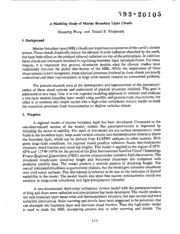Table Of Content93-20105
A Modeling Study of Marine Boundary Layer Clouds
Shouping Wang and Daniel E. Fitzjarrald
1. Background
Marine boundary layer(MBL) clouds are important components of the earth's climate
system. These clouds drastically reduce the amount of solar radiation absorbed by the earth,
but have little effect on the emitted infrared radiation on top of the atmosphere. In addition,
these clouds are intimately involved in regulating boundary layer turbulent fluxes. For these
reasons, it is important that general circulation models used for climate studies must
realistically simulate the global distribution of the MBL. While the importance of these
cloud systems is well recognized, many physical processes involved in these clouds are poorly
understood and their representation in large-scale models remains an unresolved problem.
The present research aims at the development and improvement of the parameteri-
zation of these cloud systems and understand of physical processes involved. This goal is
addressed in two ways. One is to use regional modeling approach to validate and evaluate
a two-layer marine boundary layer model using satellite and ground-truth observations; the
other is to combine this simple model with a high-order turbulence closure model to study
the transition processes from stratocumulus to shallow cumulus clouds.
2. Progress
A regional model of marine boundary layer has been developed. Compared to the
one-dimensional version of the model, surface flux parameterization is improved by
including the factor of stability. The input of this model are sea surface temperature, wind
fields in the boundary layer, large-scale vertical velocity and thermodynamic structure above
the boundary layer, which can be derived from ECMWF analyses or other sources. With
given large-scale conditions, the regional model predicts turbulent fluxes, thermodynamic
structure, cloud fraction and cloud-top heights. This model is applied to the region of 20'N-
42'N and llTW- 145°N for the period of the_First_International Satellite Cloud Climatology
Project __Regional--Experiment (FIRE) marine stratocumulus intensive field observation. The
simulated steady-state cloud-top height and fractional cloudiness are compared with
available satellite data. The model predicts a realistic pattern of cloud-top height. The
overall simulated cloudiness is qualitatively realistic, but the model give excessive cloudiness
over cold ocean surfaces. This discrepancy is believed to be due to the exclusion of diurnal
variability in the model. The model results also show that marine stratocumulus clouds are
sensitive to large-scale subsidence and light precipitation (drizzle).
A one-dimensional third-order turbulence closure model with the parameterization
of long and short-wave radiation and precipitation has been developed. The model predicts
not only boundary layer mean wind and thermodynamic structure, but also second and third
turbulent correlations. Solar warming and drizzle have been suggested to be processes that
can decouple the boundary layer and decrease cloud fraction. Thus this high-order model
is used to study the MBL decoupling process due to solar warming and drizzle. The
119
sensitivity of simulated clouds to the subgrid-scale condensation scheme is also evaluated.
The simulation of the decoupled structure observed in FIRE show that both solar
warming and drizzle contribute to the decoupling process, although solar absorption appears
to have larger influence on the modeled mean structure. The effects of drizzle on turbulent
structure also depend on the large-scale conditions such as sea surface temperature and
wind. Under low sea surface temperature and light wind conditions, drizzle may very
effectively decouple the MBL. High SST and strong wind shear increase turbulent kinetic
energy production so that the decoupling effect is significantly reduced. Our study also shows
that the simulated decoupling and cloud formation process in a high-order model may be
sensitive to subgrid-scale condensation scheme.
3. Focus of current research and plans for next year
In the process of developing the two-layer boundary layer model, we have found
some undesired features of the model. For example, the model is extremely sensitive to the
cloud-base transition layer and mass flux parameter (pointed out by other researchers). Thus
we currently try to improve the model formulation to account for the characteristics of
different convective regimes. The GLOBE data has been processed to obtain cloud-top and
cloud-base heights. The model is being used to simulate these data from the GLOBE
observation. This application is intended to verify the model formulation.
We plan to use the regional boundary layer model to study the diurnal variation of
stratocumulus clouds. In this practice, we will use ECMWF analyses to provide time-
dependent large-scale conditions and SSM/I precipitable water observation to give better
estimation of moisture above the cloud-top height. Then we can simulate the diurnal
variation of MBL observed during FIRE and study its effects on surface fluxes and cloud
albedo. We will also try to extend the one-dimensional high-order turbulence closure model
to three dimensional version. Then we can study meso-scale variability of marine boundary
layer clouds and compare the results from two type of three-dimensional models.
4. Publications and reports
Wang, S., 1992: The breakup of marine stratocumulus clouds in a two-layer boundary layer
model. (accepted by J. Atmos. Sci.)
Wang, S., B.A. Albrecht, and P. Minnis, 1992: A regional simulation of marine boundary
layer clouds (accepted by J. Atmos. Sci.)
Wang, S., and Q. Wang, 1992: Some drizzle effects on the turbulent structure of cloud-
topped marine boundary layer: A model sensitivity study. (Abstract submitted to the
Tenth Symposium on Turbulence and Diffusion, Sept. 29-0ct. 2, 1992)
Wang, S., and D. Fitzjarrald, 1992: Sensitivity of simulated marine stratocumulus clouds to
subgrid-scale condensation scheme in a third-order turbulence closure model.
(Abstract submitted to the Tenth Symposium on Turbulence and Diffusion, Sept. 29-
Oct. 2, 1992)
120

